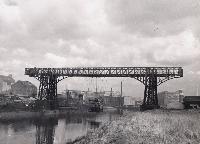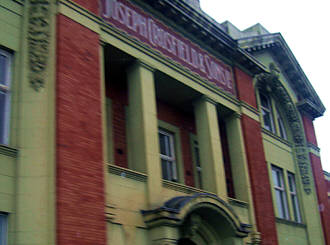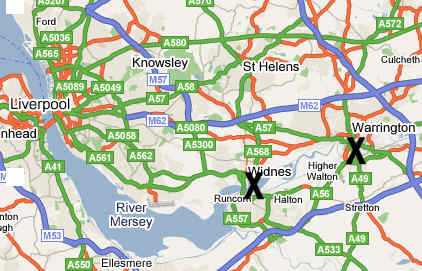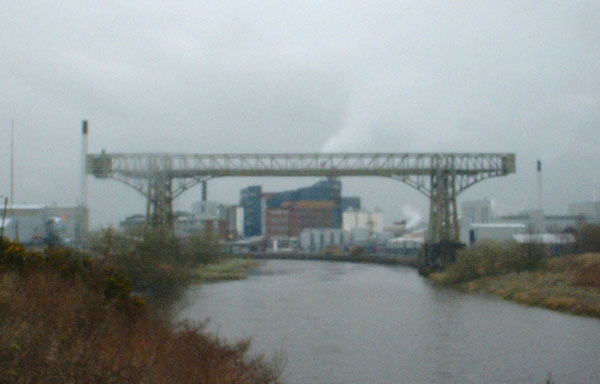
LINKS UNTEN
Neue
Website eines
Freundeskreises
Website
mit Angaben
über
die Fähre
von
Warrington
A Walk around Warrington and the Manchester Ship Canal
![]()
Spanish fly in to see
view from the bridge
by Gareth Dunning
ONE of the most unusual landmarks in Warrington
received a special visitor this week.
The Warrington Transporter Bridge, owned by Ineos,
is one of only eight of its kind in Europe and was inspected by Rocio
Velasco, from the World Transporter Bridge Association.
The Spanish visitor, who came to Warrington especially for the day, also
paid a visit to the Town Hall to meet deputy Mayor Clr Pauline
Nelson and her consort David Spencer.
![]()
En la localidad de Warrington
llegaron a construirse dos puentes de tipo transbordador. El primero en
1908, se utilizaba para unir dos fábricas que separaba el río
Mersey. En 1916 se inaugura el segundo, dedicándose también
a la actividad industrial, ya que unia dos fábricas de jabón
separadas por el rio. Fue declarado en 1976 monumento industrial, haciéndose
cargo de su mantenimiento el Ayuntamiento de Crosfield.
![]()
In the locality of Warrington two
transporter bridges were built. The first in 1908 was used to
join two factories separated by the Mersey river. In 1916, the second one
was inaugurated, also to be used for industrial purposes as it joined two
soap factories that were separated by the river. In 1976
it was declared an industrial monument, being maintained by the Crosfield's
town council.
Alfredo Pérez Trimino: "Puente Vizcaya - mi vida en imágines", Bilbao, 2000.
Lastesel
auf
der
Risikoliste
Die Crosfield's Transporter Bridge (Bank Quay Transporter Bridge) im Industriegebiet von Crosfields Chemicals in Warrington - der Urzelle des Lever-Konzerns - überbrückt den River Mersey. Sie befindet sich unweit der ehemaligen Schwebefähre Widnes - Runcorn.

Historischer Crosfields-Verwaltungssitz
Die Fähre - eines von weltweit acht noch existierenden Bauwerken dieser Art - ist außer Betrieb, steht unter Denkmalschutz und wurde wegen ihres schlechten Zustands auf die Risikoliste der Denkmalschützer gesetzt.

Schwebefähren über den River Mersey
![]()
The Warrington Transporter Bridge (or Bank Quay
Transporter Bridge) across the River Mersey has a span of 187 feet (57
m). It was built in 1916 and has been out of use since circa 1964.

This bridge is listed by English Heritage as Grade II* but presently it is on their buildings at Risk Register because of its poor condition. It is also a Scheduled Ancient Monument.
![]()
BANK QUAY 1. 5150 Transporter Bridge to part of
Joseph Crosfield and Sons Ltd's Works SJ 58 NE 5/160 II 2. 1913/4. Engineers:
Sir William Arrol and Coy. Steel. 4 brick plinths. 2 pairs of latticed
piers 70 ft high supporting a clear span of 200 ft, from which the transporter
deck is suspended. Formerly conveyed motor vehicles and railway waggons
(from a private branch leading off the former LNWR main line) to the part
of Crosfield's works which is situated in a loop in the river Mersey.
![]()
...another transporter bridge is still in existence
at Crosfields Chemicals (the original Lever's factory) at Walton near to
Warrington. The Crosfields bridge spans the old Mersey
and Irwell Navigation which was the precursor to the Manchester
Ship Canal and is scheduled as a listed structure.
![]()
Crosfields, the Warrington soap and chemicals
manufacturer, built a transporter bridge (which transfers people and goods
by a transporter car pulled by a cable) across the river in 1905
to link the company's main site at Bank Quay with its cement
works on the south bank of the river.
A replacement was built in 1916. The second bridge cost £35,000 (the cost would have been just over £1 million today) and was designed by Sir William Arrol & Co., bridge and crane builders based in Glasgow, Scotland. The control cab was on top of one of the bridge columns, in comparison with the Runcorn - Widnes transporter bridge, where the driver was in the transporter car that went across the river. The transporter bridge was no longer used by the 1970s but it still stands, and is protected by listed building status.
![]()
One of only three remaining transporter bridges
in Britain, the other two being at Middlesbrough and Newport. It was built
for the transportation of chemicals and goods to and from Crosfield's works.
Warrington's transporter bridge is on private land. Joseph Crosfield built
his chemical works here in 1814, his principal product being soap.
The bridge carried raw materials and manufactured goods between different
parts of the works, which are located on the banks of the Mersey, still
tidal at Warrington. The river meanders as it passes to the south of the
city and Crosfield�s works on the south bank are surrounded by the river
on three sides. There used to be a larger transporter bridge for public
road traffic much further downriver at Runcorn (SD512835).The bridge's
towers on both banks are founded on mass concrete cellular caissons. Double
steel cantilevers on each tower support a central 200ft span of riveted
mild steel plates and angle irons. The travelling
car, or platform, was originally built for rail traffic of up
to 18 tons, but it was modified in 1940
so that it could also take road traffic. In 1950, the bridge�s load-carrying
capacity was increased to 30 tons and the overall length of the structure
was increased to 339ft. The bridge is 30ft wide and provides 76ft clearance
at high water, though it has been out of service for several years.
![]()
Warrington is a town of bridges. The first crossing
point of the River Mersey was discovered, in what is now known as Warrington,
by ancient man, when a settlement first grew up beside this ancient ford.
"The Romans later recognised the importance of the ford's strategic position
and, to safeguard the crossing point established a settlement nearby, calling
it Veratinum." Warrington became an important staging post on the road
from north to south and rapidly grew into an important
trading centre. As Britain became industrialised, Warrington
followed, becoming a manufacturing town. Gradually it became the centre
of many industries.
In recent years, Warrington was granted "New Town" status which led to a rapid, planned expansion of the town, many new homes, jobs and industrial and commercial growth.
Today's Warrington covers an area of 43,527 acres and combines the best of progressive industrial and commercial activity with varied and pleasant housing developments, spacious parks and recreation areas, leisure and shopping centres and pleasant countryside walks.
On the
danger
list
![]()
The Crosfields bridge spans the old Mersey and
Irwell Navigation which was the precursor to the Manchester Ship Canal
and is scheduled as a listed structure.
Warrington Transporter Bridge was constructed in 1916, but hasn�t been in use since 1964 although it is maintained in working order.
This bridge was built to the design of William Henry Hunter and constructed by Sir William Arrol. It was used to carry goods across the river Mersey to the works. The bridge consists of a tower on each bank carried by concrete foundations. Cantilevers on each tower support a suspended span. The whole structure is built up from riveted mild steel plates and angles. The car was originally built to carry rail traffic of up to 18 tons in weight. It was modified in 1940 to take road traffic as well and in 1950 it was strengthened to carry loads up to 30 tons. The structure is 30ft. wide and, after the modifications, its length is 339 ft. overall. There is a clearance of 76 ft. above high water level and a clear span of 200 ft.
Warrington Guardian,
july 2001:
Six town properties go on the danger list. - Six Warrington properties are in danger of being lost forever due to neglect and decay, according to a new report by English Heritage. The 2001 register of grade one and two listed buildings highlights important historical buildings. "There is much to be done," said Sir Neil Cossons, chairman of English heritage. "The buildings need long-term stewardship if we are to save them from future generations to enjoy".... One of the more unusual structures on the register is the Bank Quay transporter bridge near Crosfields, which is owned by the Borough Council. Built in 1904 the bridge is no longer usable, but its gondola is intact.
![]()
Warrington (1908). Se construyeron dos puentes
de tipo transbordador. El primero, realizado por Thomas Piggot y Cia de
Birmingham,fue utilizado para unir dos fábricas separadas por el
río Mersey. Actualmente se utiliza para e1 transporte exclusivo
de mercancías. El segundo puente empezó su construcción
en 1913 pero no fue inaugurado hasta 1916 debido a retrasos causados por
fa Primera Guerra Mundial. Su altura es de 22,5 metros y la longitud
del travesano de 56 metros. Cayó en desuso en 1964 tras la apertura
de una nueva carretera en la orilla sur de Crosfiel vía Taylor Street,
aunque siguió utilizándose hasta los setenta (Fomento).